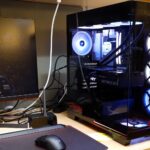Orbiting at an altitude of 250 miles (400 kilometers) above Earth, astronauts on board the International Space Station (ISS) get an unparalleled view of the cosmos resting above the planet’s horizon. Hoping to take advantage of the space station’s window to the skies, NASA astronaut Don Pettit came prepared for his ISS mission, packing a tracking device that’s been helping him capture long-exposure images of surrounding stars and galaxies.
In a recent post on X, Pettit shared a photo he had captured from the window of the SpaceX Dragon crew spacecraft, docked to the ISS. The image shows a celestial field littered with stars, and two galaxies from the Milky Way’s local group. “I flew a home-made tracking device that allows time exposures required to photograph star fields,” Pettit wrote on X. “Stay tuned for more photos like this.”
Pettit’s home-made star tracker, a motorized mount that sits between a camera and a tripod to counteract the motion of the stars, is quite impressive. It allows us to see a clear view of the stars from low-Earth orbit instead of the usually blurry photographs captured from the ISS.
In space, you can see stars!
I flew a home-made tracking device that allows time exposures required to photograph star fields.
Stay tuned for more photos like this. pic.twitter.com/OO57o4oU8l— Don Pettit (@astro_Pettit) December 5, 2024
The two galactic figures are of the Large Magellanic Cloud and the Small Magellanic Cloud, according to LiveScience. They are both among the Milky Way’s closest neighbors, and can be spotted in the night skies from the southern hemisphere.
The Large Magellanic Cloud is a satellite galaxy located around 160,000 light years away from Earth, and it contains around 30 billion stars. Its smaller counterpart, the Small Magellanic Cloud, is a dwarf galaxy with about 3 billion stars. It’s slight further away, located about 210,000 light years away from Earth. Both galaxies are believed to act as galactic satellites, orbiting around our Milky Way galaxy as it travels through the cosmos.
Pettit’s image of the two galaxies side-by-side puts the universe in perspective. This isn’t the astronaut’s first attempt at beaming down views from the ISS. Earlier this month, Pettit captured what he referred to as “cosmic fireflies,” floating outside the space station, which were actually Starlink satellites reflecting sunlight.
The NASA astronaut launched to the ISS in September, riding on board a Russian Soyuz crew capsule as part of the Expedition 72 mission. At 69 years old, Pettit is the oldest active astronaut at NASA, logging in more than 370 days in space and over 13 hours of spacewalk time, according to NASA. Having spent all that time in space, the astronaut is still curious about the surrounding cosmos and he’s taking us along for the ride.
Read the full article here












